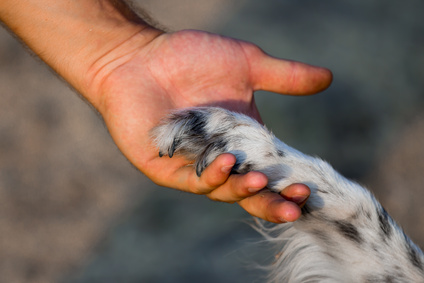
When a dog’s nails become too long they interfere with the dog’s gait and as the nails continue to grow, walking will become awkward and painful. Walking on overgrown nails puts pressure on the toe joints. This can eventually affect the joint alignment and cause a future of continual discomfort for your dog. Untrimmed nails can also split resulting in pain, bleeding, and a trip to the veterinarian’s office. In severe cases the nails curl under and grow into the paw pad causing a serious infection. Trimming your dog’s nails regularly will easily prevent these problems.
It is best to start trimming your dog’s nails as soon as possible. If you start early it’s easier to adjust to a routine. Make a habit of handling your puppy’s feet every day. Nail trimming is much easier if your dog doesn’t mind having his feet handled. Adult dogs, like people, are usually set in their ways. So if your dog initially resists getting his nails trimmed you will most likely need to spend more time getting him used to the procedure. Be very patient and don’t rush.
Bring out the clippers ahead of time and let your dog become familiar with them. Stay calm, if you’re nervous, your dog will sense it and associate fear with nail trimming. If your dog is nervous use gentle reassurance, being careful not to coddle. Let her know that you expect her to behave. If you can only manage to get one toenail trimmed that’s all right. Just be persistent and try for another nail at another time. Always remember to reward good behavior with praise and a favorite treat.
Trimming nails is not usually considered sharing “quality time” with your pet. But if done often and properly while rewarding good behavior, it could be an event your dog will tolerate and even look forward to. If not done often with proper technique, and praise and reward- training, it can be frightening and painful for your dog. Once or twice a month is usually a good rule of thumb for nail trimming. Trimming nails is not as hard as it may seem. Start by clipping very small pieces of the nail tip until you can see a dark, round, kind of moist looking disk appear in the middle of the nail. This means you’re approaching the quick and the nail will bleed if you cut it any shorter. With white or clear nails, trim 1/8 of an inch longer than pink area. Dogs that walk on cement or rough surfaces can wear down their nails, but most dogs need some help. You will get to know how fast your dog’s nails grow if you routinely inspect them. Even if you aren’t actually trimming them, regular inspection will help assure that your dog’s feet stay healthy. So make nail inspection and trimming an important part of your dog’s routine.
Dog nail trimming is not painful if you use a sharp trimmer and don’t clip too short. A dull trimmer puts pressure on the nail and can result in an uncomfortable pinching sensation.
It’s a good idea to have styptic powder on hand for those occasional mishaps. A nail clipped just a little too short tends to bleed a lot. Applying styptic powder will help stop the bleeding. If you do not have styptic powder, you can use baking flour. Packing this on the nail and allowing your dog to rest can stop the bleeding. If the bleeding does not stop, contact your veterinarian.
Nail trimming is a regular home grooming task that helps keep your dog healthy and active. As with most dog grooming tasks, rewarding for positive behavior is an important part in the acceptance and tolerance of the activity. Learning the tricks to proper nail trimming, training with positive feedback, and showing patience and love will make the time you spend together a reward in itself.




